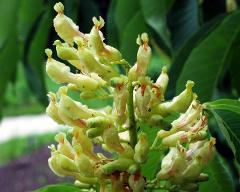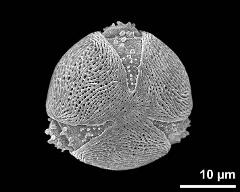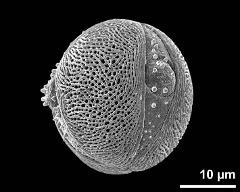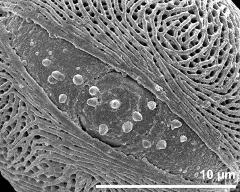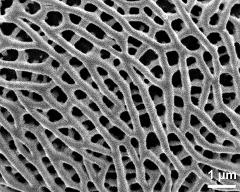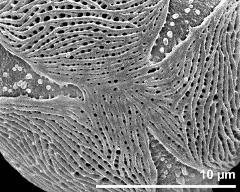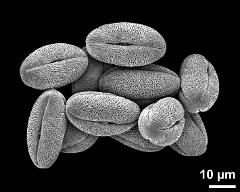Aesculus flava
Taxonomy: Spermatophyta, Sapindales, Hippocastanaceae, Aesculus
Published: 2005-07-19
Pollen Description
Shape, Size and Aperture
pollen unit: monad, dispersal unit and peculiarities: monad, size (pollen unit): medium-sized (26-50 µm), size of hydrated pollen (LM): -, shortest polar axis in equatorial view (LM): -, longest polar axis in equatorial view (LM): -, shortest diameter in equatorial or polar view (LM): -, longest diameter in equatorial or polar view (LM): -, pollen class: -, polarity: isopolar, P/E-ratio: -, shape: spheroidal, outline in polar view: circular, dominant orientation (LM): -, P/E-ratio (dry pollen): prolate, shape (dry pollen): -, outline in polar view (dry pollen): lobate, infoldings (dry pollen): aperture(s) sunken, aperture number: 3, aperture type: colporus, aperture condition: colporate, aperture peculiarities: aperture membrane ornamented
Ornamentation and Structure
LM ornamentation LM: -, nexine: -, sexine: -, SEM ornamentation SEM: striato-reticulate, suprasculpture SEM: -, TEM tectum: semitectate, infratectum: -, foot layer: -, endexine: -, intine: -, wall peculiarities: -, supratectal element: -
Miscellaneous
pollen coatings: absent, reserves in cytoplasm: -, cell number: -, Ubisch bodies: absent
Author(s) of diagnosis: Halbritter, H.
Pictures
Picture legend
- flower(s), photographer: Halbritter, H.
- polar view - fresh, rehydrated (water) & critical point dried & sputter coated with gold, photographer: Halbritter, H.
- equatorial view - fresh, rehydrated (water) & critical point dried & sputter coated with gold, photographer: Halbritter, H.
- detail of aperture - fresh, rehydrated (water) & critical point dried & sputter coated with gold, photographer: Halbritter, H.
- exine surface - fresh, rehydrated (water) & critical point dried & sputter coated with gold, photographer: Halbritter, H.
- polar area - fresh, rehydrated (water) & critical point dried & sputter coated with gold, photographer: Halbritter, H.
- dry pollen grains - dry, sputter coated with gold, photographer: Halbritter, H.
Literature
- (1976) An atlas of pollen of the trees and shrubs of Eastern Canada and the adjacent United States. Part III. Leguminosae to Cornaceae. Univ Waterloo Biol Ser 10: 1-37
- (1937) European bee plants and their pollen. Bee Kingdom League, Alexandria, Egypt : 164 pp
- (1984) A practical pollen guide to the British flora. Quaternary Res Bull Technical Guide I: 1-139
- () Pollenformen und Honigherkunftbestimmung. Bücher des Archivs für Bienenkunde, Berlin 2: 1-122
- (1971) Atlas des pollens des environs d'Istanbul. Istanbul Universitesi, Orman Fakultesi publication : 1-330
- (1986) Claves para la determinación de los polenes de las principales especies melíferas de la Península Ibérica. Orsis 2: 27-54
- (1942) Lehrbuch der Pollenanalyse. Handbücher der praktischen Vorgeschichtsforschung. Verlag Ferdinand Enke, Stuttgart 3: 195 pp
- (1963) The genera of Sapindales in the southeastern United States. J Arn Arb 44: 462-501
- (1963) Pollini aerodiffusi e le pollinosi. Instituto d'Igiene dell'Universita Palermo : 214 pp
- (1985) Alcuni cenni sulla biologia del polline. Aerobiologia 1: 31-38
- (1993) Aportación a la palinología de plantas ornamentales de la ciudad de Sevilla. III. Lagascalia 17: 87-103
- (1877) Pollen. Hardwicke & Bogue, London : 92 pp, 24 pl
- (1952) Pollen morphology and plant taxonomy. Angiosperms. Almquist & Wiksell, Stockholm
- (1964) Text book of pollen analysis. Scandinavian University Books, Munksgaard : 1-237
- (1890) Beiträge zur vergleichenden Morphologie der Pollenkörner. Breslau (Thesis) : 1-72
- (1832) Beiträge zur Kenntnis des Pollen. Berlin, Stettin und Elbing : 48 pp, 2 pl
- (1985) Nuevas aportaciones al catálogo aeropalinológico de Córdoba: plantas exóticas. An Asoc Palinol Leng Esp 2: 215-225
- (1986) Pollen flora of North-West Himalaya. Indian Association of Palynostratigraphers, Lucknow : 181 pp, 29 pl
- (1842) Observations on the structure of the pollen granule, considered principally in reference to its eligibility as a means of classification. Ann Mag Nat Hist 8 & 9: 92-108, 544-573
- (1925) Nectar producing plants and their pollen. British Bee Journal, London : 1-110
- (1984) The Northwest European Pollen Flora 34. Hippocastanaceae. Rev Palaeobot Palynol 42: 111-119
- (1974) The pollen loads of the honeybee. Bee Research Association, London : 150 pp
- (1979) Pollen morphology and microsporogenesis in Hippocastanaceae. Diss Abstr Int B 40: 562 pp
- (1958) An atlas of airborne pollen grains. Macmillan & Co Ltd, London I-XVI: 1-112
- (1956) Pollen grains of Japan. Hirokawa Publishing Co, Tokyo I-XII: 1-304
- (1972) Flora alergogena de Espana. Anal Real Acad Farmacia 38: 521-570
- (1969) How to know pollen and spores. Nature series. Wm C Brown Company publisher, Dubuque, Iowa X: 249 pp, 499 figs
- (1983) Airborne and allergenic pollen of North America. The John Hopkins Univ Press, Baltimore : 254 pp
- (1986) Studies of pollen morphology in the Bretschneideraceae and the relative families. Acta Bot Yunn 8: 441-450
- (1966) The pollen morphology of the subfamily Papilionaceae (Leguminae). NSF Research participation report : 21 pp
- (1978) Pollini allergenici in Emilia-Romagna. Dipartimento ambiente-territoria-trasporti della Regione Emilia-Romagna 13: 1-79
- (1987) Polenes del Jardín Botánico de Valencia I. An Asoc Palinol Leng Esp 3: 73-90
- (1960) Pollens de plantes mellifères d'Europe - I. Pollen et Spores 2: 159-182
- (1834) Über den Bau und die Formen der Pollenkörner. Beiträge zur Anatomie und Physiologie der Gewächse. Erstes Heft. Bern 4: 130 pp, 6 pl
- (1835) Sur la structure et les formes des graines de pollen. Ann Sci Nat, Ser 2 3: 148-180, 220-236, 304-346
- (1978) An illustrated guide to pollen analysis. Hodder & Stoughton Ltd, Kent : 133 pp
- (1991) Pollen analysis. Blackwell Scientific Publications. Second Edition : 216 pp
- (1961) Pollen grains of Indian plants. I. Bull Nat Bot Gard Lucknow 53: 1-35
- (1965) Pollen grains of Western Himalayan Plants. Asia Monographs, India 1 VIII: 1-102
- (1943) Diagnostic characters of pollen grains. Sci Rep Tôhuku Univ, 4th ser 17: 491-512
- (1988) Identificación de los polenes de la flora ornemental de la ciudad de Granada. Ars Pharmaceutica 29: 93-105
- (1977) Atlas of airborne pollen grains and spores in Northern Europe. Natur Och Kultur, Stockholm : 159 pp
- (1901) Recherches morphologiques sur le pollen des Dialypétales. Journ de Bot : 15-166, 194-204, 218-222, 419-422
- (1981) Structure and function in angiosperm pollen wall evolution. Rev Palaeobot Palynol 35: 39-59
- (1989) Palcomp - 90. Generatore di schede palinologiche. In: Guerrini A. (ed) Flora palinologica siciliana, Consiglio Nazionale delle Ricerche : 327 pp
- (1961) Pollen. Talleres graficos DCP, Gerona
- (1830) De Cellulis antherarum fibrosis nec non de granorum pollinarium formis: Commentatio phytotomica. Pressburg : 58 pp, 18 tab
- (1992) Pollen et spores d'Europe et d'Afrique du Nord. Laboratoire de Botanique historique et Palynologie, Marseille : 520 pp, 446 pl
- (1981) Pollen identification for bee keepers. Univ College Cardiff Press : 111 pp
- (1973) Palynomorphs of Japanese plants. Spec Publ Osaka Mus Nat Hist 5: 1-60
- (1962) Kartoteka Palynologiczna Roslin Polskich. Opolskie Towarzystwo Przyjaciol Nauk, Zeszyty Przyrodnicze 10: 117-149
- (1971) Automation of identification procedures in palynology using taxonomic data matrices. In: Beaman J.H. (ed) Some applications for the taxonomic data matrix. Flora North America Report 63: 67-90
- (1965) Electron microscopic investigations on the surface structure of pollen membrane of trees. Sci Rept Kyoto Univ, Agr 17: 43-69
- (1987) Monografia polenului florei din Romania. Vol. II. Acad Rep Soc Romania : 144 pp
- (1975) Die Morphologie des Pollens und deren Bedeutung für die Bestäubung der Bienenpflanzen von Rumänien. CR III Symp International sur la pollinisation. Prague, 1974. Bull Tech apicole (Suppl) 2: 293-316
- (1963) Contributie la cunoasterea structurii morfologice a microsporilor Hippocastanaceelor si Sapindaceelor din Flora R.P.R. Anal Univ Buc Sér Biol 12: 31-36
- (1978) Apertural forms and their evolutionary trends in the pollen grains of Indian Papilionaceae. Ind J Bot 1: 133-138
- (1960) Pollen grains of China. : 276 pp
Copyright and Citation
Cite this publication as:
Halbritter H. 2005. Aesculus flava. In: PalDat - A palynological database. https://www.paldat.org/pub/Aesculus_flava/112363;jsessionid=F1853D9DE4F9A512538CF0AFF9C0A538; accessed 2024-04-19

